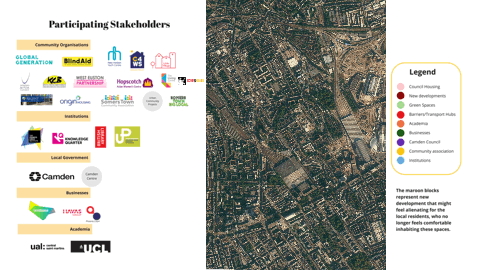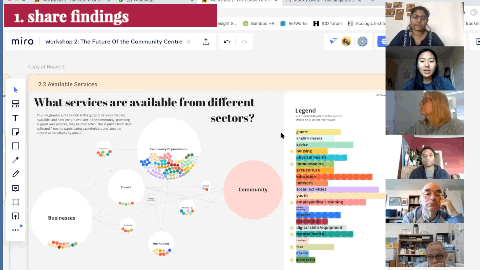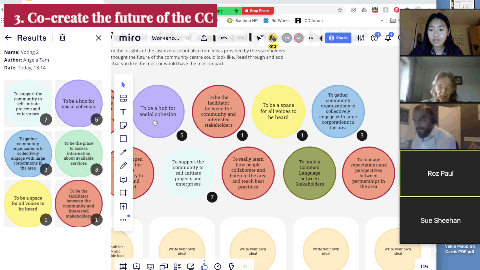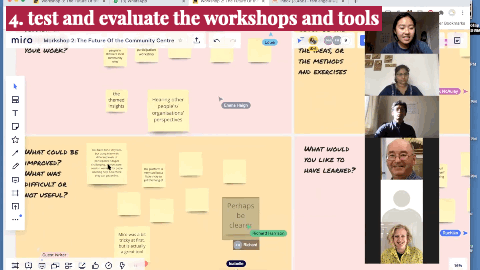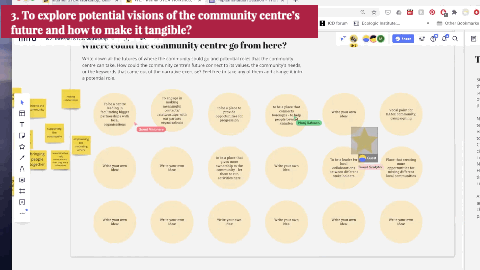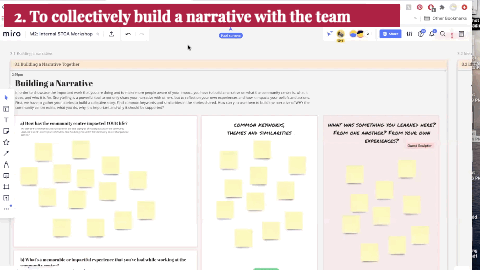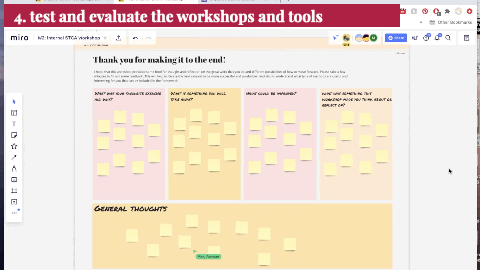
Collaborative Communities
Collaborative Communities is a project that aims to support community-minded organisations to create more meaningful partnerships across sectors and to build interdependent, interconnected local communities
// Overview // The Challenge // Project Partners // Methodology // Tools // Challenges // Process // Final Deliverables // Key Learnings // Impact //
Watch a short film on the project.
Project Stakeholders and Collaborators: Somers Town Community Centre, Public Collaboration Lab, Camden Participation Team
Project Duration: 8 months
My role: Design Researcher, Systems Designer, Service Designer, Workshop Facilitator
Skills Strengthened: Project management, user research, participatory design methods, research through design, workshop creation, data synthesis, multi-stakeholder engagement, group facilitation, tool creation, community-led design, managing client relations, design activism
Project output: Masters of Service Design (with Distinction) Final Thesis; the Collaborative Communities Service Design Playbook - An open source playbook of service design activities and methods to enable community-minded organisations and individuals to take on a more collaborative and co-produced approach within their own teams and beyond.
The Challenge
This project began as an exploration of how to create better, more meaningful cross-sector collaborations to remediate a system of silos, competitiveness, and duplication of work, particularly within the area of social impact and community building and with a focus on how the private sector could better pitch in. Through research conducted in the Kings Cross Somers Town area (London, UK) in partnership with the Somers Town Community Association and Living Centre, the project responded to the insights and findings discovered and pivoted its focus away from the private sector to support those who are working on the ground every day to address the needs of their communities. Through working closely with many community organizations and individuals, I realized that my role was to support them in their work and to equip more people with the right tools to get involved as well. As a designer, I believe that design has a role to empower communities to be more collaborative, creative, and agile.
Through identifying that our current systems are failing us and we are in need of radical change across sectors, I believe that better collaborations can lead to the democratization of power between private, public, academic, social sectors and local communities, creating more resilient solutions that take into account a wide range of expert and lived perspectives, employ risk, resource and capacity sharing, and tackle challenges from multiple angles to understand the roots of pressing problems.


Project Partners
After extensive research to understand the existing context of cross-sector collaboration, the brief of this project was further developed in partnership with Sarah Elie MBE, CEO of the Somers Town Community Association and Living Centre, a well established pillar of the Somers Town community in the borough of Camden in London.
Throughout this project, I engaged with almost 100 community stakeholders, from community organisations, academia, private sector and local institutions, to local governments. My aim was to co-create the future of the community centre model through understanding the existing service ecology and community needs, and to develop methods and mindsets that could be used to foster more collaborative thinking and meaningful partnerships.

snapshots of somers town
Methodology
This project loosely followed the Double Diamond methodology of Discover, Define, Develop, and Deliver, though the reality of working with a live project necessitated a more dynamic approach that could navigate the quick changes and developments that can occur when working with many community stakeholders. Therefore, the scope of the project began broad to allow for a comprehensive discovery of the research question unencumbered by presumptuous design solutions, and narrowed through allowing the research to guide the design process and pivot to the uncovered user needs.

Project Methodology and Timeline
I also utilized action research and research through design, complementary methodologies that simultaneously take action (through design activities), and generate knowledge to inform and conduct research (Giaccardi and Stappers, n.d.), to understand current contexts of cross-sector collaboration and how to foster better and more meaningful collaborations through gathering and working with many community stakeholders across the Kings Cross Somers Town area.
Working backwards, I would often dissect the types of thinking and mindsets I wanted participants to utilize, and then create specific tools and activities in order to facilitate this thought transformation. Multiple workshops conducted with over 50 community stakeholders and 12 STCA staff were used to not only create new findings, but also to test and validate how the tools and workshops themselves were working and how they could be iterated and improved.
As part of the research through design process, the project utilized participatory design methods to create a more collaborative research environment and used design activities and workshops to unlock discussion, ideation, imagination, and knowledge exchange between stakeholders.
Tools
As my final academic project, I took this opportunity to explore many different methods of research and engagement, understanding that this was a rare chance to spend so much time on a project where the direction could be completely dictated by research findings. This included participatory and co-design methods, causal layered analysis, and human-centred design.
Most interactions remained online due to the severity of London’s lockdowns, therefore I worked on Miro to collate my research and findings and to conduct interactive workshops and testing sessions. I utilized Zoom (like the rest of the world) to conduct many exploratory and in-depth interviews, as well as my workshops. I also capitalized on online networks to conduct an exploratory survey that engaged almost 30 participants from around the world.
For design tools, I took inspiration from other practitioners and events to create fit-for-purpose tools that could best support my stakeholders to undertake a journey in thinking systemically and collaboratively. Among tools that I created myself, I also adapted tools from Dr. Lara Salinas on Knowledge Exchange, and from Grace Ascuati and Mary Wharmby on Change Management for organisations. I also utilized traditional design tools such as personas, journey maps, service blueprints, and business model canvases to develop and reflect on my research and design concepts.
Challenges
Working alone
Previous to this project, I was accustomed to working in teams where we could often discuss, collaborate, and split tasks to complete the work. As an individually driven final thesis, this project became my baby. Amplified by the pandemic, I mostly worked alone, and it would be easy to get stuck into a dread cycle questioning every decision ever made, over-analyzing until anything and everything lost its meaning. In those instances, conversations with fellow designers, friends, and mentors made all the difference. Seeing the project with a fresh perspective, they were able to give me insights that had become lost to me. I learned, just because you may be working alone on a project doesn’t mean that you have to do everything alone, in fact, it can be to your design process’s detriment.
Virtual Everything
As with everything, all research and engagement became remote. It was difficult not being able to go meet people in person, and to barely even step foot into the community centre that I spent 8 months working with! However, I also recognize that this situation created an added benefit for me as it had lowered the barrier for more interested stakeholders to speak with me and attend my workshops, now that they could quickly hop on from the comfort of their own homes in between their own work schedules. In conducting interviews and workshops entirely online, I gained valuable skills in virtual group facilitation and a keen understanding on how to engage participants in an online environment. Unlike in person events, which are easier to “go with the flow”, online workshops require more structure to create a safe and comfortable space for all participants. In fact, with the proper tech training to make sure that every participant is on the same page, one might argue that an online space is even more democratic and accessible for all participants to share their thoughts.
Process
To understand the current contexts and appetites for cross-sector collaboration, I first conducted exploratory interviews with varied industry experts, desk research, and an online survey to gather stories, pains, successes and methods of collaboration.

Shortly into my exploration, I was introduced to Sarah Elie from the Somers Town Community Association, who was interested in mapping the existing service ecology of the Somers Town area to understand current needs and services and to strategize for the future of the community centre. I found an opportunity to use this existing community and particular locality to better understand and test cross sector collaboration to benefit communities.
*King’s Cross, where the STCA is located, is a fascinating intersection of diversity. Many see it as the new hub for innovation, with huge corporations like Google and universities like UCL and CSM. However, only minutes away, many local residents live in council housing and have higher than average rates of poverty, unemployment, and youth crime, the community remaining vibrant but underserved.

I created an interview guide through grouping what I needed to find out and interviewed a broad range of stakeholders, from community organizations, businesses, schools, charities, to Camden Council staff who were all invested in the area. At the same time, I took a Change Management Through Design course at CIID (Copenhagen Institute of Interaction Design) which gave me a different perspective on how change can not only happen with the collaborations you take on, but also, it must be accepted and embraced within the organization.
After over 30 in-depth interviews, I sat on an overwhelming mountain of data that needed to be synthesized and made useful. Firstly, I looked at the physicality of the neighbourhood, which made clear that
a) stakeholders are very close in proximity
b) the new developments could be very alienating for the community who is being squeezed out.

I mapped the different services available for patterns, and common community needs I heard from stakeholders. I found a mix of tangible needs, such as access to jobs and healthy food, but also more abstract ideals and ways of working. At the same time, I collected key insights from many people on what components created a successful collaboration.
What I heard from many organizations was this interest in building better partnerships with businesses, and the hope to take a step back amidst the firefighting, and to devise a way forward. I began to think about how the work I was doing might support more organizations, who were doing such incredible and meaningful work, to become more resilient to the changes ahead, and how I could support them create more dynamic collaborations within the area. What if I used my current research process as a case study to create a framework with tools that could support others to do the same?
I organized 4 sets of workshops attended by over 50 interested community stakeholders, which served several purposes.
To give the research back to the community - to be transparent and accountable - and show thankfulness for the time they had contributed
to emulate and share the service design process and methodologies
to co-create the future of the community centre with the community
and also to help me evaluate the tools that I had created to see if they were really helpful for people and whether they were inspiring collaboration, systemic and design thinking, and also to evaluate the interest in this different way of working
Next, I created a complementary set of tools for a separate series of workshops with the staff of the community centre. I realized, in order to implement this co-created future, it was essential to first gather the team to reflect on the organization’s existing infrastructure.
The second set of workshops explored the following.
to build a collective understanding of what the community centre already does, according to its staff.
to collectively build a narrative with the team
to explore potential visions of the community centre’s future and how to make this tangible.
and finally, to continue evaluating the workshop and tools
Some examples of workshops and activity iterations along the way…
Having supported the community centre to build up this research, I then moved backwards to piece together all the tools I had created, testing and iterating with different potential users to uncover which areas might need more development.
I created and organized the tools to correspond with an end-to-end human-centred collaborative journey that could be picked up by any non-designer to use in their own projects or organizations, from conducting research, to understanding your own organization and narrative, to identifying partnerships and ideas together with other stakeholders, and to finally sustaining these partnerships in a meaningful and co-produced way.
Final Deliverables
The deliverable that came out of this piece of work is the Collaborative Communities Service Design Playbook, an open source playbook of service design activities and methods that hopes to enable community-minded organisations and individuals to take on a more collaborative and co-produced approach within their own teams and beyond. Each activity has been tested within a live project context, and comes with a set of instructions, resources needed, why you should use it and for what purpose, and the template itself.

Example pages of the playbook







Final Service Blueprint
Key Learnings
Making my own tools
At the beginning of my masters program, I held a lot of trepidation for the design process, and I was keen to learn all the tools and methods, such as personas and journey maps, in order to feel like a professional. Consistently, my tutors responded with, “the tools aren’t important, they are here to support the design.” This made no sense to me, but as the months wore on, I realized that I was doing just that, that I had built the skills to create my own tools and workshops to be fit for purpose, finally ending up with a playbook of my own set of tools for collaborative thinking and action! Through trusting my process and understanding my project, I was able to leave behind the nagging feeling that I had to check off certain exercises (eg creating personas), even when it didn’t progress my project goals.
Importance of Self Reflection
In relation to working alone, it was also important to remember to take those frequent steps backwards to look at the full picture. I would often reflect on my work to question particular design decisions. I asked myself, why am I doing what I am doing? Is the project pivoting to align with new research findings? Does this enrich my body of work or does it detract from it? Is this path getting me to where I need to go? In these moments, honesty and humility was necessary to throw away pieces that no longer made sense, even when time and effort had been spent on them.
Setting Client Expectations
Working on this project as an independent study without a paying client allowed me the freedom to move with the research and not against it. I chose to work with a partner, the Somers Town Community Association, in a way that felt mutually beneficial to us. To do so, I had to be extremely clear about what I could and could not provide, and to be proactive in presenting my services and skills to fit into their existing work. I discovered a fine line between keeping the client in the loop but also trusting my own process to make decisions. As a student, it can be too easy to dismiss your own skills and rely on more “professional” figures to make decisions. However, I recognised two major factors in working with a partner organisation.
Clients are extremely busy managing their own projects and day to day operations, and if you rely on them to give instructions or to make decisions that hinder the progress of your project, you will spend all of your time waiting.
I am the expert in my field, just like they are the expert in theirs. For matters relating to their work, organisation, users, and network, I knew clearly that I was coming in as an outsider, and therefore leaned on them for their knowledge and experience. However, in matters related to design, research, workshops and prototypes, I offered my own expertise and understanding.
Holding myself accountable
I recognised that the reason that so many people were willing to speak with me and attend the workshops was because the findings of my research were also extremely pertinent to them. Therefore, it was super important to me to be appreciative of their time, not only in gratitude but also in remembering to keep them updated on what happened within the work itself. Too often, it can be easy to finish up a project and forget about it. However, by acknowledging that the people I was working with would continue the work long after I left, and by preparing my work in a way that they could take up and implement, I also leave the legacy of my work to support and benefit the community. In this way, a project also becomes that much more meaningful knowing that I am hopefully paving the way for lasting impact.
Impact
This project was selected as a highlight for the London College of Communication’s Design School Graduate Showcase and received top honours for its quality of research and implementation. Different pieces of the playbook have been tested, presented, and or used at the University of the Arts Knowledge Exchange Network to understand the impact of the university’s community projects, the Camden Participation Team and Camden Co-Production Network and the Department of Education in the UK Central Government.
When thinking about the legacy of this piece of work beyond the final major project, it was incredibly important to remain faithful to the collaborative and inclusive spirit that this project aimed to encompass. Therefore, the final playbook will be shared with all stakeholders who have engaged with this project and will also be available for open source download. A request to those who engage with the activities and methods provided will be to share back their uses, processes, and modifications to the service creator to enable further understanding of the playbook’s potential and to create iterations of the activities and frameworks that will best support different sectors and contexts. Due to the relatively short timeframe of the final major project, this playbook deliverable represents the minimal viable product that can create impact within the community, and does not encompass the full breadth of the service, which can be expanded into a 3 tiered model.

Open source playbook
A playbook of activities and methods to facilitate service design thinking in community organisations and to create better collaborations across sectors. This will be provided open source for anyone who can benefit from this and to share the design practice and methodology more widely to make design inclusive.

Training Program
A training program to “train the trainers” to use these tools and activities on their own, without actually facilitating the process. This tier will be for those who have some resources and would like a more in-depth knowledge of how to use the methods and activities.

Consultancy
A Service Design consultancy/facilitator contract to create bespoke activities that are fit for purpose for a particular organisation, conduct research, facilitate workshops, and gather findings. This tier is for those who would like to be supported by an expert through the entire process.
Different stakeholders across the Somers Town area are keen to take this work forward, and have expressed interest to support others in the community to utilise these methods once they themselves have become familiar. Trainers may be STCA, the Public Collaboration Lab, and even staff within Camden Council, such as the Camden Participation Team, who are actively engaged in supporting co-production across community organisations through projects such as the Camden Renewal Commission and the Inclusive Innovation Network. This playbook may be helpful to support these stakeholders to continue building capacity in the community.
Future development will include building a bespoke website to house the Collaborative Communities playbook, training, and consultancy/facilitation services, as well as interesting case studies of the activities being used in different contexts, and to place the toolkit as a downloadable template on Miroverse, an online library of tools and frameworks. Future development may also include building more robust training materials to support workshop facilitation, service/idea validation, and user research.








